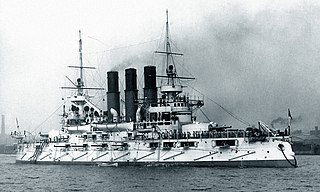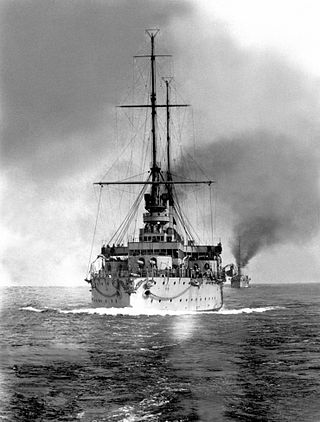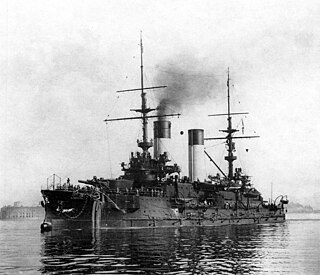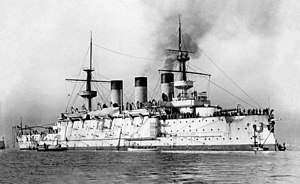
Retvizan was a pre-dreadnought battleship built before the Russo-Japanese War of 1904–1905 for the Imperial Russian Navy. She was built by the American William Cramp & Sons because Russian shipyards were already at full capacity. Named after a Swedish ship of the line that was captured during the battle of Vyborg Bay in 1790, Retvizan was briefly assigned to the Baltic Fleet, but was transferred to the Far East in 1902.

The Borodino-class battleships were a group of five pre-dreadnought battleships built for the Imperial Russian Navy around the end of the 19th century. Their design was based on that of the French-built Tsesarevich modified to use Russian equipment. The first four ships were finished after the start of the Russo-Japanese War of 1904–1905 and were among the ships ordered to sail from the Baltic Sea to the Far East to relieve the Pacific Squadron besieged by the Japanese in Port Arthur. Three of these ships were sunk and one was captured by the Imperial Japanese Navy at the Battle of Tsushima in 1905. The fifth and final ship, Slava, was not completed in time to participate in the war and served with the Baltic Fleet through World War I.

Nisshin (日進), also transliterated as Nissin, was a Kasuga-class armored cruiser of the Imperial Japanese Navy, built in the first decade of the 20th century by Gio. Ansaldo & C., Sestri Ponente, Italy, where the type was known as the Giuseppe Garibaldi class. The ship was originally ordered by the Royal Italian Navy in 1901 as San Rocco and sold the next year to the Argentine Navy who renamed her Mariano Moreno during the Argentine–Chilean naval arms race, but the lessening of tensions with Chile and financial pressures caused the Argentinians to sell her before delivery. At that time tensions between the Empire of Japan and the Russian Empire were rising, and the ship was offered to both sides before she was purchased by the Japanese.

Kasuga was the name ship of the Kasuga-class armored cruisers of the Imperial Japanese Navy, built in the first decade of the 20th century by Gio. Ansaldo & C., Sestri Ponente, Italy, where the type was known as the Giuseppe Garibaldi class. The ship was originally ordered by the Royal Italian Navy as Mitra in 1901 and sold in 1902 to Argentine Navy who renamed her Bernardino Rivadavia during the Argentine–Chilean naval arms race, but the lessening of tensions with Chile and financial pressures caused the Argentinians to sell her before delivery. At that time tensions between the Empire of Japan and the Russian Empire were rising, and the ship was offered to both sides before she was purchased by the Japanese.

Tsesarevich was a pre-dreadnought battleship of the Imperial Russian Navy, built in France at the end of the 19th century. The ship's design formed the basis of the Russian-built Borodino-class battleships. She was based at Port Arthur, northeast China, after entering service and fought in the Russo-Japanese War of 1904–1905. Tsesarevich was torpedoed during the surprise attack on Port Arthur and was repaired to become the flagship of Rear Admiral Wilgelm Vitgeft in the Battle of the Yellow Sea and was interned in Qingdao after the battle.

Pobeda was the last of the three Peresvet-class pre-dreadnought battleships built for the Imperial Russian Navy at the end of the nineteenth century. The ship was assigned to the Pacific Squadron upon completion and based at Port Arthur from 1903. During the Russo-Japanese War of 1904–1905, she participated in the battles of Port Arthur and the Yellow Sea. Having escaped serious damage in these engagements, Pobeda was sunk by gunfire during the siege of Port Arthur, and then salvaged by the Japanese and placed into service under the name Suwo (周防).

The Petropavlovsk class, sometimes referred to as the Poltava class, was a group of three pre-dreadnought battleships built for the Imperial Russian Navy during the 1890s. They were transferred to the Pacific Squadron shortly after their completion in 1899–1900 and were based at Port Arthur before the start of the Russo-Japanese War of 1904–1905. All three ships participated in the Battle of Port Arthur on the second day of the war. Petropavlovsk sank two months after the war began after striking one or more mines laid by the Japanese. Her two sister ships, Sevastopol and Poltava, took part in the Battle of the Yellow Sea in August 1904 and were sunk or scuttled during the final stages of the siege of Port Arthur in early 1905.

Rostislav was a pre-dreadnought battleship built by the Nikolaev Admiralty Shipyard in the 1890s for the Black Sea Fleet of the Imperial Russian Navy. She was conceived as a small, inexpensive coastal defence ship, but the Navy abandoned the concept in favor of a compact, seagoing battleship with a displacement of 8,880 long tons (9,020 t). Poor design and construction practices increased her actual displacement by more than 1,600 long tons (1,600 t). Rostislav became the world's first capital ship to burn fuel oil, rather than coal. Her combat ability was compromised by the use of 10-inch (254 mm) main guns instead of the de facto Russian standard of 12 inches (305 mm).

The Ekaterina II class were a class of four battleships built for the Imperial Russian Navy in the 1880s. They were the first battleships built for the Black Sea Fleet. Their design was highly unusual in having the main guns on three barbettes grouped in a triangle around a central armored redoubt, two side-by-side forward and one on the centerline aft. This was intended to maximize their firepower forward, both when operating in the narrow waters of the Bosphorus and when ramming. Construction was slow because they were the largest warships built until then in the Black Sea, and the shipyards had to be upgraded to handle them.

Navarin was a pre-dreadnought battleship built for the Imperial Russian Navy in the late 1880s and early 1890s. The ship was assigned to the Baltic Fleet and spent the early part of her career deployed in the Mediterranean and in the Far East. She participated in the suppression of the Boxer Rebellion in 1900 before returning to the Baltic Fleet in 1901. Several months after the beginning of the Russo-Japanese War in February 1904, she was assigned to the 2nd Pacific Squadron to relieve the Russian forces blockaded in Port Arthur. During the Battle of Tsushima in May 1905, she was sunk by Japanese destroyers which spread twenty-four linked mines across her path during the night. Navarin struck two of these mines and capsized with the loss of most of her crew.

The Russian battleship Poltava was one of three Petropavlovsk-class pre-dreadnought battleships built for the Imperial Russian Navy in the 1890s. The ship was transferred to the Pacific Squadron shortly after completion and based at Port Arthur from 1901. During the Russo-Japanese War of 1904–1905, she participated in the Battle of Port Arthur and was heavily damaged during the Battle of the Yellow Sea. She was sunk by Japanese artillery during the subsequent siege of Port Arthur in December 1904, but was raised by the Imperial Japanese Navy (IJN) after the war and renamed Tango (丹後).

Oryol was a Borodino-class battleship built for the Imperial Russian Navy in the first decade of the 20th century. The ship was completed after the start of the Russo-Japanese War in February 1904 and was assigned to the Second Pacific Squadron sent to the Far East six months later to break the Japanese blockade of Port Arthur. The Japanese captured the port while the squadron was in transit and their destination was changed to Vladivostok. Oryol was badly damaged during the Battle of Tsushima in May 1905 and surrendered to the Japanese, who put her into service under the name of Iwami.

Peresvet was the lead ship of the three Peresvet-class pre-dreadnought battleships built for the Imperial Russian Navy at the end of the nineteenth century. The ship was transferred to the Pacific Squadron upon completion and based at Port Arthur from 1903. During the Russo-Japanese War of 1904–1905, she participated in the Battle of Port Arthur and was seriously damaged during the Battle of the Yellow Sea and again in the siege of Port Arthur. The ship was scuttled before the Russians surrendered, then salvaged by the Japanese and placed into service with the name Sagami (相模).

Knyaz Suvorov was one of five Borodino-class pre-dreadnought battleships built for the Imperial Russian Navy in the first decade of the 20th century. Completed after the beginning of the Russo-Japanese War in 1904, she became the flagship of Vice admiral Zinovy Rozhestvensky, commander of the Second Pacific Squadron. The squadron was sent to the Far East a few months after her completion to break the Japanese blockade of Port Arthur. The Japanese captured the port while the squadron was in transit and their destination was changed to Vladivostok. During the Battle of Tsushima on 27 May 1905, the ship fell out of the battle line after a shell hit her bridge, killing her helmsman and wounding her captain and Rozhestvensky. Knyaz Suvorov was eventually torpedoed and sunk by Japanese torpedo boats; other than 20 wounded officers evacuated by a destroyer, there were no survivors.

Oslyabya was the second of the three Peresvet-class second-class pre-dreadnought battleships built for the Imperial Russian Navy at the end of the nineteenth century, although construction delays meant that she was the last to be completed. The ship was part of the Second Pacific Squadron sent to the Far East during the Russo-Japanese War of 1904–05, and served as the flagship of Rear Admiral Baron Dmitry von Fölkersam. Oslyabya was sunk on 27 May 1905 at the Battle of Tsushima, and was the first all-steel battleship to be sunk by naval gunfire alone. Sources differ on the exact number of casualties, but over half her crew went down with the ship.

Borodino was the lead ship of her class of five pre-dreadnought battleships built for the Imperial Russian Navy in the first decade of the twentieth century. Completed after the beginning of the Russo-Japanese War in 1904, Borodino was assigned to the Second Pacific Squadron that was sent to the Far East a few months after her completion to break the Japanese blockade of Port Arthur. The Japanese captured the port while the squadron was in transit and their destination was changed to Vladivostok. The ship was sunk during the Battle of Tsushima in May 1905 due to explosions set off by a Japanese shell hitting a magazine. There was only a single survivor from her crew of 855 officers and enlisted men.

Imperator Aleksandr III was one of five Borodino-class battleships built for the Russian Imperial Navy in the first decade of the 20th century. The ship was completed a few months before the start of the Russo-Japanese War in February 1904 and was assigned to the Second Pacific Squadron that was sent to the Far East six months later to break the Japanese blockade of Port Arthur. The Japanese captured the port while the squadron was in transit and their destination was changed to Vladivostok. During the Battle of Tsushima in May 1905, Imperator Alexander III was sunk by Japanese gunfire with the loss of 778 men, her entire crew.

The Fuji class was a two-ship class of pre-dreadnought battleships built for the Imperial Japanese Navy (IJN) in the mid-1890s. They were the first battleships in the IJN, and were constructed in the UK as Japan lacked the industrial facilities needed to build them. Their design was based on the battleships being built for the Royal Navy at that time.

The Shikishima class was a two-ship class of pre-dreadnought battleships built for the Imperial Japanese Navy in the late 1890s. As Japan lacked the industrial capacity to build such warships herself, they were designed and built in the UK. The ships participated in the Russo-Japanese War of 1904–1905, including the Battle of Port Arthur on the second day of the war. Hatsuse sank after striking two mines off Port Arthur in May 1904. Shikishima fought in the Battles of the Yellow Sea and Tsushima and was lightly damaged in the latter action, although shells prematurely exploded in the barrels of her main guns in each battle. The ship was reclassified as a coast defence ship in 1921 and served as a training ship for the rest of her career. She was disarmed and hulked in 1923 and finally broken up for scrap in 1948.

Sevastopol was the last of three ships in the Petropavlovsk class of pre-dreadnought battleships built for the Imperial Russian Navy in the 1890s.

























